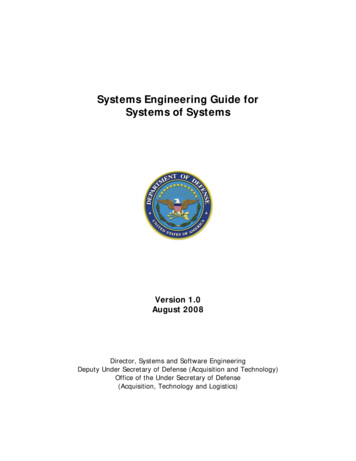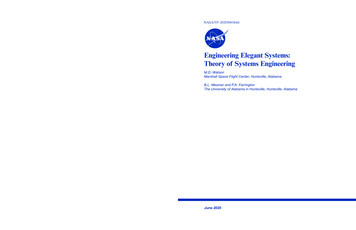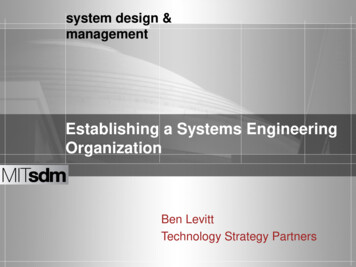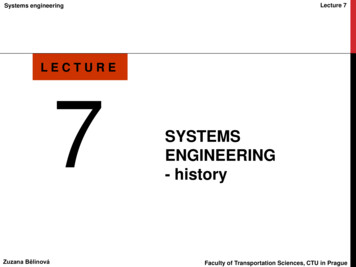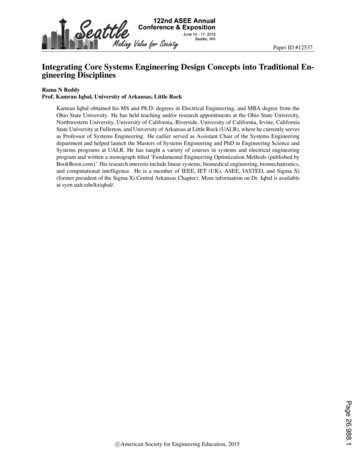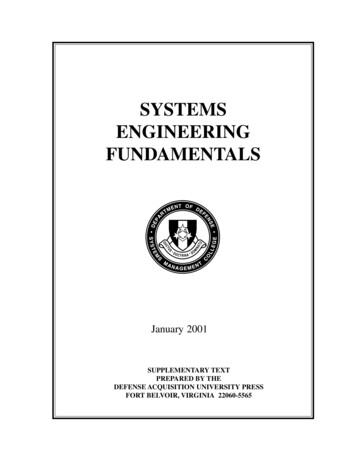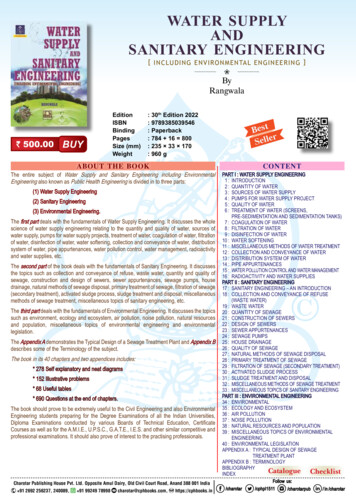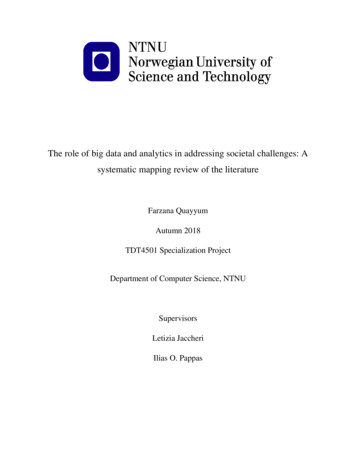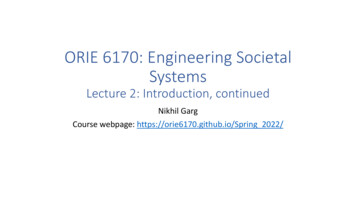
Transcription
ORIE 6170: Engineering SocietalSystemsLecture 2: Introduction, continuedNikhil GargCourse webpage: https://orie6170.github.io/Spring 2022/
Announcements Watch out for the course pre-survey, posted on Slack soon Papers for discussion and reviews also posted soonNext week Tuesday – Guest lecture: Nihar Shah (CMU) Thursday – No class (I’m at a Simons workshop)
g9Iv5YsSgp0E1dRVmNpvfK 1Z5e1fazlm7Uk/edit
Assignments GradingFinal project: 35%Paper review presentation: 25%Presentationfeedback: 15%Paper reading anddiscussion: 15%Participation: 10%Everything graded on a 0-3 scale:0: Didn’t turn it in1: Inadequate/low effort2: Pretty good (most grades)3: ExcellentAll 2’s an “A” in the course
Class structure 10-15 days discussing papers 3-5 lectures by me 5 guest lectures 3 days paper review presentations 1 day project proposal presentations 2-3 days project presentations
Course communicationCourse Slack channel: First place for any question/commentOffice hours: Happy to chat about anything – sign up on link in syllabusEmail: Try to avoid; but preferred over private message on Slack.Most materials posted to course website:https://orie6170.github.io/Spring 2022/
Classroom norms Take space, make space: allow others to join the conversation, butplease contribute as you feel comfortable. Embrace a growth mindset. Not understanding something in a paperis the default. Ask questions! Be willing to give and receive feedback respectfully. Zoom normsFeel free to take video-off breaks as necessary, and a couple lectures of videooff the entire time. But I expect you to mostly keep video on and participateduring the paper discussion lectures
Reminder: Cross-cutting methodologyQuestions you need to answer What is your [the system’s] lever? What is your objective function? How do people react to your lever? What are people’s preferences? What are people’s strategy spaces? How to model people’s behavior? Rational ? How do people affect each other? What is the information space? What do you know? What data do you have? What do people know? How do you acquire more information?Common tasks Understand your domain Write a model for the ?s on the left Calculate “equilibria” Estimate preferences from historical data Simulate counter-factual worlds Experiment/Psuedo-experiment Deploy a systemMethods used Applied modeling/stochastics Game theory/mechanism design Optimization, Algorithms Machine learning/statistics/data science Online learning/decision-making
Why active engineering ofsocietal systems is needed
Susan Athey at a recent panel:"online marketplaces have mostly been started by libertarians.themost consistent theme is that people think marketplaces will be finejust with prices, but then they realize they need to impose rules for themarketplace to succeed"
Markets and Societal systems often failWhy? Lack of coordination – selfish behavior by everyone makes everyoneworse off. “Price of anarchy” Lack of information/time – individuals have constraints Fraud/other strategic behavior – manipulation by some makes othersworse off Multiple equilibria, including some bad’ onesOne role of the market designer/engineer is to prevent such failures
An example: Market for lemonsGeorge Akerlof, “The Market for Lemons: Quality Uncertainty and theMarket Mechanism”
Main Idea – single seller Suppose I have a boxWith equal probability, either: Nothing Cup of coffee?I know what’s in the box, but you don’t Coffee is worth 1 to me 1.50 to you Does a sale happen?If I can guarantee coffee, you pay me somewhere in [ 1, 1.50] and we’re both happyIf I can’t, you offer me 0.75 Do I say yes?Knowing the above, would you ever offer me 0.75?
Extending this to a marketRandom between 0 and 4 cups you’d be willing to pay 3 (2*1.5) No one with 4 cups would acceptBetween 0 and 3 cups you’d be willing to pay 2.25 (1.5*1.5) No one with 3 cups would accept Eventually only the empty box is left, the “lemon”
Modern Example – HealthcareYoung & HealthyElderly and Sick What happens when insurers can’t price discriminatebased on status?Average prices go up so young & healthy flee the marketOk so you mandate that everyone buys insurance, and hope themandate is strong enoughOf course healthcare is a bad example of a free market. Mandate waseffectively repealed, with little apparent effect.
Main IdeasMain concepts:1. Information Asymmetry & Adverse Selection2. Price reveals information rational expectations3. Markets can unravel; converge to and then stuck in non-Paretoefficient allocations4. How can design help us here? What if we had a reputationsystem with repeat transactions? Or an independent auditor?Markets for Lemons are everywhere1. Healthcare2. The sharing economy: eBay, AirBnB, Lyft, Upwork
More involved example:Residency matching
The market failureSimilar unraveling to what we saw above: Hospitals (especially less glamorous ones) started hiring futureresidents earlier and earlier during medical school ( 1940s) In response, other hospitals also started hiring earlier. The marketunraveling, such that students were being offered residency positionsbefore they knew what they wanted to do (this is clearly bad) Many other labor markets have seen the same unraveling [Roth andXing (1994)]
Initial solution desiderata In 1940s, a few attempts to fix the problem that didn’t work well By 1951, a centralized algorithm would match doctors and hospitalsWhat are participants action spaces/what is the system lever? Doctors and hospitals each give ranked lists of the other side Anyone can lie about their true preferences [Algorithm does the matching; assigns each doctor to a hospital] Doctors and hospitals can break their match Suppose algorithm produces matches (A, X) and (B, Y). But Doctor A likes Y X, andhospital Y likes A B. Then, (A,Y) can defect from the system and instead match with each other
Initial solution: Gale-Shapley in 1 slide Desiderata: Doctors and Hospitals each submit truthful ranked lists After the algorithm produces its solution, there is no “blocking pair”: thereexists no (A,Y) that would want to leave their assigned partner for each other How it works:
Summary of theory of Gale-Shapley Theorem: A stable matching always exists [No “blocking pairs”] Theorem: Gale-Shapley algorithm finds a stable matching Theorem: Participants don’t want to lie about their preferences, butonly the “proposing” side.Problem solved? By 1970s, people started complaining again Increase in couples in medical schools wanting to match together Implementation of algorithm favors hospitals? (Over doctors?) Concerns about strategic behavior by doctors
The redesign of the market (1990s)Favoring doctors over favoring hospitals:“Simple” change to algorithm: have doctors “propose” instead of hospitals. Restof theoretical results hold. (And now, it’s strategy-proof for doctors!).Couples: harder case -- Stable matching may not existBUT, some hope: Computational simulations suggest that in practice stable matchings almostalways exist Follow up theory (e.g., Nguyen & Vohra 2018): “for any student preferences,we show that each instance of a matching problem has a "nearby" instancewith a stable matching”
Problem solved forever?Theory differs from practice in many ways Empirically, many doctors still mis-report their preferences. Why? The algorithm assumes people know everything about the other side,and can rank as many as they want In practice, this is not true: you must interview at a school to even have achance. So, if you only interview at top schools and don’t get any Opposite problem: what if the same top 10 doctors interview everywhere (50hospitals, each with 1 position)? Evidence that this happened last few years due to Zoom interviewing Recent proposal to have a centralized matching system for interviews: Explaining aPotential Interview Match for Graduate Medical Education Journal of Graduate MedicalEducation (allenpress.com)
Lessons from residency matching Systems can fail due to seemingly minor incentives issues (causes bad equilibria) Designing even a limited system is hard and often politically tense Interplay between theory, empirical analysis, and simulation“It turned out that the simple theory offered a surprisingly good guide to the design, andapproximated the properties of the large, complex markets fairly well. Field and laboratory datashowed that the static idea of stability went a long way towards predicting which kinds ofclearinghouse could halt the dynamics of unraveling. And computation showed that many ofthe departures from the simple theory were small, and that some of the most severe problemsthat the counterexamples anticipated, such as the possibility that no stable matching wouldexist, were rare in large markets. Computation also revealed that large markets could achieveeven nicer incentive properties than anticipated by the simple theory.” Objective functions matter! (Doctor vs hospital optimal) People often don’t behave “optimally,” but that doesn’t make theory useless Even if one component of the system is provably optimal, surroundingcomponents (here, interview process) might undo benefits
Some nice quotes from Al Roth (2002) The largest lesson in all this is that design is important because markets don’t always grow like weeds—someof them are hothouse orchids. Time and place have to be established, related goods need to be assembled,or related markets linked so that complementarities can be handled, incentive problems have to beovercome, etc. If game theory is going to be as important a part of design economics as it is a part ofeconomic theory, we’ll have to develop tools not just to develop conceptual insights from simple models,but also to understand how to deal with these complications of real markets. In the long term, the real test of our success will be not merely how well we understand the generalprinciples that govern economic interactions, but how well we can bring this knowledge to bear on practicalquestions of microeconomic engineering Just as chemical engineers are called upon not merely tounderstand the principles that govern chemical plants, but to design them, and just as physicians aim notmerely to understand the biological causes of disease, but their treatment and prevention, a measure of thesuccess of microeconomics will be the extent to which it becomes the source of practical advice, solidlygrounded in well tested theory, on designing the institutions through which we interact with one another
So what has changed since 2002? Rise of online marketplaces (and more generally, computationalsystems) has made the type of work he described ubiquitous What’s difference? These applications are far “messier” Faster (many times a second, as opposed to once a year) Many complexities; not a ‘closed’ system. (in ride-hailing, pricing affectsmatching affects wages affects long term driver capacity ) The field is more mature, new methods, incorporation of data science We’re going to focus on these more “modern” applications Critiques of approach, as enters more sensitive areas
Announcements Watch out for the course pre-survey, posted on Slack soon Papers for discussion and reviews also posted soonNext week Tuesday – Guest lecture: Nihar Shah (CMU) Thursday – No class (I’m at a Simons workshop)
Machine learning/statistics/data science Online learning/decision-making. Why active engineering of societal systems is needed. Susan Athey at a recent panel: "online marketplaces have mostly been started by libertarians.the most consistent theme is that people think marketplaces will be fine

